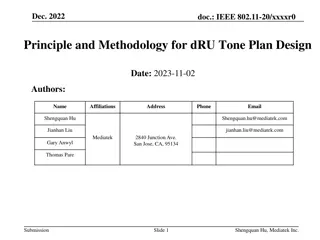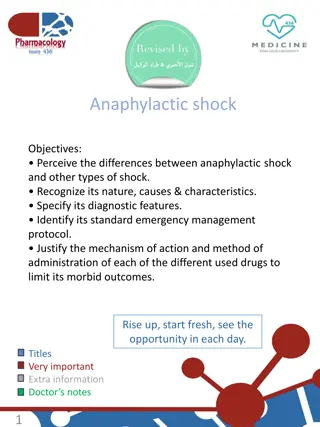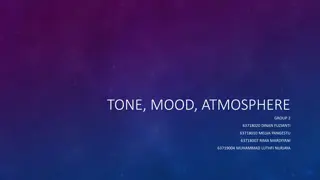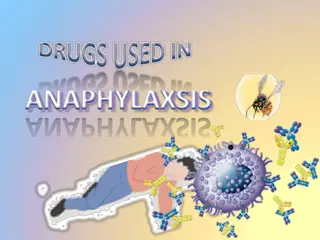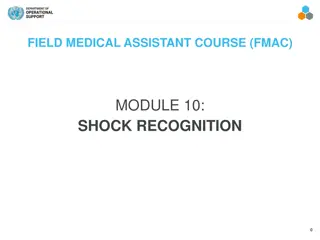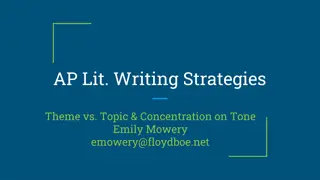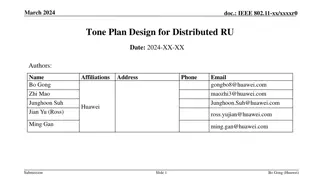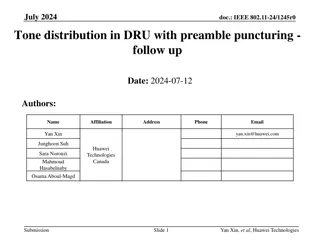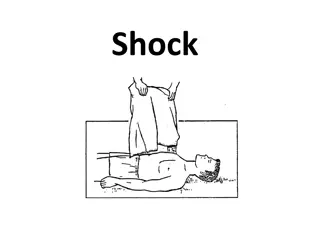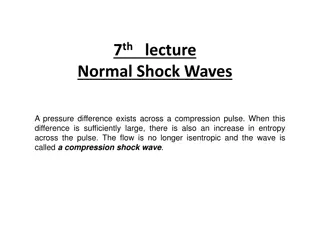
Understanding Neural Pathways in Fear Response
Explore the intricate neural pathways involved in fear conditioning, from tone and shock stimuli to amygdala activation. Engage in a virtual lab activity to grasp the connections between sensory input and fear responses. Dive into neurobiological concepts to comprehend the mechanisms behind fear states.
Download Presentation

Please find below an Image/Link to download the presentation.
The content on the website is provided AS IS for your information and personal use only. It may not be sold, licensed, or shared on other websites without obtaining consent from the author. If you encounter any issues during the download, it is possible that the publisher has removed the file from their server.
You are allowed to download the files provided on this website for personal or commercial use, subject to the condition that they are used lawfully. All files are the property of their respective owners.
The content on the website is provided AS IS for your information and personal use only. It may not be sold, licensed, or shared on other websites without obtaining consent from the author.
E N D
Presentation Transcript
Neurons connect to each other via synapses Tone comes in as a series of spikes or electrical impulses from the neuron in the sensory neuron in the ear. The axon of the tone neuron connects to the amygdala neuron via a synapse shown in the figure two semi- cylindrical pieces with a gap in between. The synapse has two parts; the left side is called pre- synapse and is connected to the tone neuron, and the right part is called the post-synapse and is connected to the amygdala neuron. The electrical impulse is transmitted from the pre- to the post- synapse via neurotransmitters. This is the role of the synapse, i.e., to transmit electrical impulses from one neuron to another. Let s see how this information can be used to study the two neural pathways. One is between tone and the amygdala, and the other is between shock and the amygdala. Optional if you are interested, you can learn more about synapses using web resources. Axon from tone neuron Synapse Amygdala neuron Generated in our Lab- Neural Engineering Laboratory, University of Missouri-Columbia 2
What is the neural pathway for the tone reward and fear cases? The pathway for food stimulus and for shock stimulus is similar. Can you sketch them for the fear conditioning case? Generated in our Lab- Neural Engineering Laboratory, University of Missouri-Columbia 3
Putting both pathways together in the overall simplified fear circuit Note: All signals go through the thalamus (relay station!) in our brains. Generated in our Lab- Neural Engineering Laboratory, University of Missouri-Columbia 4
ACTIVITY 3.1 YOUR CHALLENGE: Go into the virtual lab provided at the link below https://phet.colorado.edu/en/simulations/circuit-construction-kit-dc and click on the play button to get started. Now put together both the tone and shock pathways using the simulator, both connecting to the same amygdala neuron. Solution provided at the end for the teacher.
REVIEW. How does the tone-only configuration work? First let s understand the big picture and some neurobiological concepts Load the code What-is-Fear.ipynb to the Colab site, research.google.com, and do Run All as usual. Generated in our Lab- Neural Engineering Laboratory, University of Missouri-Columbia Sliders on screen: You can adjust the tone frequency and the tone strength. Plots on screen: Top: Times when the tone spikes reach amygdala, and Bottom: membrane potential V of amygdala neuron (spike if V > 0 mV) 1. How is firing of the amygdala related to fear? Based on this, how do we define the fear state in this set of tutorials? 2. Do normal sounds (tones) cause the amygdala to elicit fear? What sounds do? Explain the logic. 6
REVIEW. How does the tone-only configuration work?....cont. You explore how the two parameters (i) tone frequency and (ii) tone-PN synaptic strength affect firing rate of amygdala PN using the Colab code What-is-Fear.ipynb Generated in our Lab- Neural Engineering Laboratory, University of Missouri-Columbia Now that you are familiar with the setup of the tutorial . 1. The baseline firing rate of the amygdala can be considered to be 0.5 Hz (most cells are silent). You are to find tone strength settings to make sure the amygdala neuron fires at 0.5 Hz, and note it below: 2.The fear state firing rate of the amygdala is 7 Hz. How will you adjust the tone strength to cause the amygdala neuron to fire at 7 Hz. This state is accomplished after fear conditioning, details of which we will consider in Colab tutorials Intro-to-Tone-Shock.ipynb and . 7
Activity 3.2 - How do tone and shock cause plasticity in amygdala? Now consider tone and shock pathways as shown in slide 1 using code Intro-to-Tone-Shock.ipynb. Try various combinations of parameters to explore how to grow the tone-PN strength and learn about Hebbian plasticity rule! 1-cell Model to Illustrate Tone-shock Pairing: Tone Shock Inputs are Tone through one pathway and Shock through another pathway. Both axons ( wires ) converge onto the same amygdala neuron. The synapse will grow if the tone and shock are paired in time. That is, if they occur close enough to each other in time. The Colab code helps you determine how close the tone and shock need to be in time for the synapse to grow, i.e., get stronger. Then in next Colab Calcium-Rule.ipynb, you find out the mechanism that implements the strengthening of the synapse, i.e., makes the synapse grow. Synapse Neuron Generated in our Lab- Neural Engineering Laboratory, University of Missouri-Columbia 8
How do tone and shock cause plasticity in amygdala?....cont. Now consider tone and shock pathways as shown in slide 1 using the Colab Intro-to-Tone- Shock.ipynb. Try various combinations of parameters to explore how to grow the tone-PN strength and learn about Hebbian plasticity rule! 1. Load the code Intro-to-Tone-Shock.ipynb and do Run All as usual. Write down on a separate sheet the plots you see and what they mean. Explain each plot, particularly the one of tone-strength vs time. 2. Start with default values tone/shock frequency at 3/5 Hz, shock start time=250. Note the tone and shock do not occur at the same time. Then explain the trends in the plots you see. You will notice that it spikes with every shock, but not tone. Why is that? Write down the reason in your notebook. 3. YOUR CHALLENGE You try to adjust the relevant parameters (two frequencies and shock start time) so that the tone by itself can make the neuron fire (without the shock). Note that you can change the parameter values either using the slider or you can type into the box. If you type directly into the box, make sure you press Enter . 9
Activity 3.3 - Tone and shock cause plasticity via Ca2+ learning rule Let us know look into details by considering the mechanism by which the tone strength grows, via the Hebbian plasticity rule. For this we run the Colab Calcium-Rule.ipynb. 1. Load the Colab notebook Calcium-Rule.ipynb to research.google.com and do Run All as usual. Write down on a separate sheet the plots you see and what they mean. Explain each plot, particularly the one of tone-strength vs time. The two new plots are of tone strength vs time, and Ca2+ (calcium) pool vs time. What is the Ca2+ pool inside the neuron?: With each tone, a small amount of Ca2+enters the neuron. Since Ca2+is harmful inside a cell, it is continuously taken away in all cells ( extruded ). However, if the shock occurs close enough in time with the tone, the amount of Ca2+ that enters increases considerably. This rise in calcium is what causes the tone strength to grow. 2. Start with default values tone/shock frequency at 3/5 Hz, shock start time=250; tone/shock strengths = 1/2. Then explain the trends in the plots you see. The calcium pool size goes up to 0.2 which is not sufficient to increase the strength of the synapse. 3. YOUR CHALLENGE: Similar to what you did in the previous Colab, adjust the relevant parameters (two frequencies, shock start time and initial strengths) so that, after training, the tone by itself can make the neuron fire (without the shock). Note that this will happen only if the Ca2+ pool size grows which then makes the strength to grow. Also, note that this happens only when tone and shock are close to each other in time. 10
CONCLUSION. Amygdala is the key structure of the brain that stores various emotional memories in mammals, including humans and rodents. We modeled one neuron of the many in the amygdala that form a network, with various sub-regions storing different emotions such as reward, fear, etc. Amygdala network with >1M neurons in rodents https://upload.wikimedia.org/wikipedia/commons/8/8b/Amyg.png 11
SOLUTION FOR TEACHER: Modeling both the tone (top) and shock (bottom) pathways using the circuit model software 12 https://phet.colorado.edu/en/simulations/circuit-construction-kit-dc


